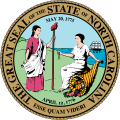North Carolina Department of Transportation
 Seal of the North Carolina Department of Transportation | |
| Agency overview | |
|---|---|
| Formed | 1979 |
| Preceding agencies |
|
| Headquarters | Raleigh, North Carolina |
| Agency executives |
|
| Website | ncdot.gov |
The North Carolina Department of Transportation (NCDOT) is responsible for building, repairing, and operating highways, bridges, and other modes of transportation, including ferries in the U.S. state of North Carolina.
History
[edit]The North Carolina Department of Transportation was formed in 1915 as the State Highway Commission. In 1941 the Department of Motor Vehicles (DMV) was formed under the NCDoT by an act of the General Assembly. The Executive Organization Act of 1971 combined the state highway commission and the DMV to form the NC Department of Transportation and Highway Safety. In 1979 "Highway Safety" was dropped when the North Carolina State Highway Patrol (NCSHP) was transferred to the North Carolina Department of Crime Control and Public Safety.[2]
Board of Transportation
[edit]The board governs the department and is the decision-making body. Fourteen board members are appointed by the governor, one each from one of the fourteen divisions, and six others appointed by the NC House Speaker and NC Senate Pro-Tempore, representing specific functions of the department that meet once a month.[3][4]
Divisions of the NCDOT
[edit]
Division of Motor Vehicles
[edit]The Division of Motor Vehicles (DMV) provides motor services like issuing licenses and permits, promote highway safety, giving accurate information about road conditions, enforcing motor vehicle laws, and keeping hold of official DMV records.[5]
Division of Highways
[edit]The Division of Highways is responsible for building and maintaining the second largest state maintained highway system in the nation, incorporating over 78,615 miles (126,519 km) of highways, and 18,540 bridges collectively spanning 376.98 miles (606.69 km).[6]
Division of Aviation
[edit]The Division of Aviation's mission is to maintain the North Carolina air transportation system development and improve aviation safety and education.[7]
Division of Bicycle & Pedestrian Transportation
[edit]The Division of Bicycle and Pedestrian Transportation (DBPT) is a division for Bicycles and pedestrian traffic. Some notable things the division does is designing facilities, creating safety programs, mapping cross-state bicycle routes, training teachers, sponsoring workshops and conferences, fostering multi-modal planning or integrating bicycling and walking into other projects by the Department of Transportation. Created in 1974 as a result of North Carolina bicycle program legislation and expanded to encompass pedestrian activities in 1992 as a result of federal legislation, the DBPT is the oldest comprehensive state program of its kind in the United States.[8]
Ferry Division
[edit]The Ferry Division is responsible for providing ferry services to public. The Ferry Division operates eight routes connecting mainland North Carolina with various outer banks and islands along the coast of North Carolina.[9]
Public Transportation Division
[edit]The NCDOT Public Transportation Division helps North Carolina public transit systems move people. The division does not operate buses, trains or vans directly – these services are operated by local transit systems – but help maintain these public transit systems. The first division director was David C. Robinson, 1974–1979. He was succeeded by David King, then Sanford Cross, Miriam Perry, and Denese Lavandere (the current director, appointed in 2012.)[10]
Rail Division
[edit]
The Rail Division is responsible for operation of six Amtrak trains within North Carolina under the NC By Train brand and works with the North Carolina Railroad Company, a state owned railroad that carries both freight and passenger rail service. The route is 317 miles (510 km) long and runs from Charlotte, North Carolina to one of the state ports at Morehead City, NC. The route passes through the cities of Charlotte, Salisbury, Lexington, Greensboro, Burlington, Durham, Raleigh, Goldsboro and on to Morehead City. The North Carolina Railroad trackage is currently leased to Norfolk Southern Railway. A small portion between Raleigh and Cary is co-operated with Norfolk Southern by CSX Transportation. The state operates no freight trains and all freight is handled by either CSX or Norfolk Southern. However, the division does own the rolling stock used on the Piedmont under the reporting mark RNCX.
| Train Name | Train Number | Train Routing |
|---|---|---|
| Piedmont | 71/72/73/74/75/76/77/78 | Raleigh to Charlotte |
| Carolinian | 79/80 | New York to Charlotte |
See also
[edit]- North Carolina Ferry System
- North Carolina Highway System
- North Carolina Turnpike Authority
- Vehicle registration plates of North Carolina
References
[edit]- ^ "NCDOT: Joey Hopkins, P.E." North Carolina Department of Transportation. October 1, 2023. Retrieved November 22, 2023.
- ^ "NCDOT: History and Organization". Archived from the original on 2006-11-04. Retrieved 2006-11-15.
- ^ "NCDOT: Board of Transportation". Retrieved 2012-04-06.
- ^ "NCDOT: Division of Highways". Retrieved 2012-04-06.
- ^ "NC Division of Motor Vehicles". Retrieved 2006-11-15.
- ^ "NCDOT Quick Facts" (PDF).Retrieved on November 12, 2007.
- ^ "NC Division of Aviation Mission & Vision".Retrieved on November 15, 2006.
- ^ "NCDOT Division of Bicycle and Pedestrian Transportation".Retrieved on November 12, 2007.
- ^ "NC Ferry Division".Retrieved on November 15, 2006.
- ^ "NCDOT, Public Transportation Division".Retrieved on November 12, 2007.


 French
French Deutsch
Deutsch